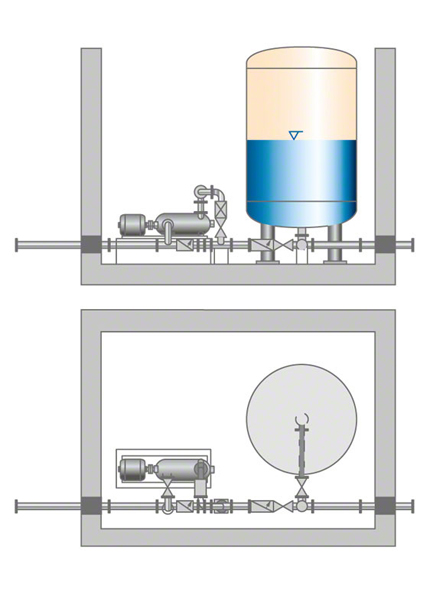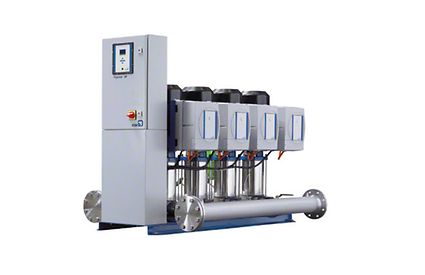Pressure booster system
 Dec 11, 2021|
Dec 11, 2021| View:571
View:571If the standard pressure of an existing water supply system is unable to ensure supply to consumers located at higher elevations, e.g. in high-rise buildings or elevated residential areas, it is necessary to boost the water pressure. This is accomplished by installing one or more booster pumps in a bypass line to the main water supply pipe.
In order to prevent any pumping in a closed circuit, a check valve is fitted in the main water supply pipe between the booster pumps' suction and discharge connections. See Fig. 1 Pressure booster system
 Fig. 1 Pressure booster system: Pump installed in bypass line with lift check valve and accumulator |  Fig. 2 Pressure booster system: Package system with four variable speed pumps, ready for installation |
Modern pressure booster systems are operated with variable speed pumps. See Fig. 2 Pressure booster system
These may also be arranged in parallel which offers the additional benefit of a wide control range. Large fluctuations in pressure upstream of the pump (inlet pressure) can be well controlled, and the pressure booster systems' variable speed pumps make them very efficient. The installation of pressure controllers/reducers can be completely dispensed with which, in turn, means that continuous pressure losses are avoided. These systems are unparalleled in terms of user convenience and operational reliability.
As the discharge pressure is virtually constant, it is only necessary that the head actually required be adjusted to match the respective inlet pressure.
This means that the pressure fluctuations/surge pressures experienced with other systems when pressure boosting pumps cut in or out are no longer felt by the user (no change in temperature when taking a shower, etc.). In addition, the system's operating noises are markedly reduced, at least when it is predominantly operated in the low flow range. If one variable speed pump fails, this does not result in pressure fluctuations or unstable operation, i.e. hunting (excessively frequent pump starting/stopping).
Normally these types of pressure booster systems also eliminate the need for pressure vessels (membrane-type accumulators) which present hygienic problems. The control and monitoring algorithms generally in use today allow zero demand (flow rate demand = 0) to be quickly and reliably identified, ensuring prompt pump shutdown and avoiding unnecessary (drinking) water heating. See Fig. 2 Pressure booster system
The relatively high expenditure for closed-loop control systems justifies the application of micro-processors. Standardised package units incorporate all the components necessary for automatic operation and can be connected with a minimum of installation work.
Source: KSB Centrifual Pump Lexicon https://www.ksb.com/centrifugal-pump-lexicon/pressure-booster-system/191754/



